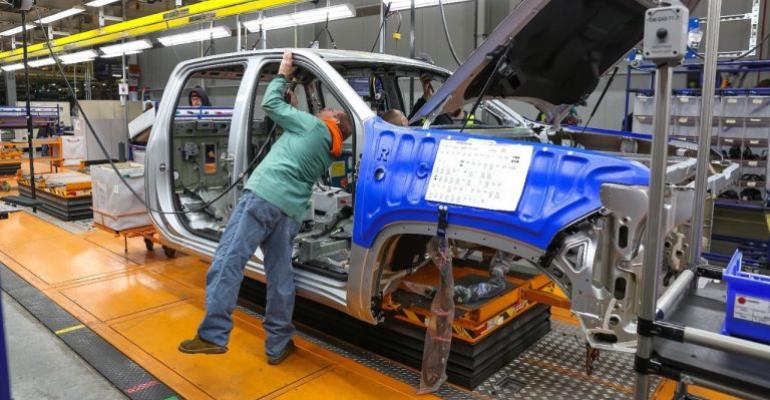As the saying goes, “money talks,” and while General Motors executives tout bold plans for battery-electric vehicles, they are also spending heavily – announcing more than $2.1 billion in investments this month alone – to bolster the company’s valuable internal-combustion-engine business and hopefully ensure peace with the UAW this fall.
The $1 billion investment in the heavy-duty truck assembly plant and adjacent stamping plant in Flint, MI, and the $500 million investment in the assembly plant in Arlington, TX, where the automaker’s market-leading fullsize SUVs are built, will strengthen GM’s business, according to Gerald Johnson, the company’s executive vice president of global markets and sustainability.
GM followed those announcements by saying it will invest $632 million in its Fort Wayne, IN, assembly plant (pictured, below) to prepare the factory for the production of next-generation ICE fullsize light-duty trucks.

The investments bolster GM’s U.S. manufacturing operations, which include more than 50 assembly, stamping, propulsion and component plants and parts distribution centers nationwide. They also highlight the company’s commitment to continue providing customers with a strong portfolio of ICE vehicles for years to come.
Product details and timing related to GM’s future fullsize SUVs are not being released at this time, Johnson says during a visit to Arlington. The automaker also says product details and timing related to trucks to be built at Fort Wayne are not being released.
“Preparing the plant to produce future ICE fullsize SUVs reflects our commitment to our valued customers and the efforts of the dedicated Arlington Assembly employees, who have been breaking production records this year,” Johnson says.
Arlington Assembly (pictured, below) builds GM’s entire portfolio of fullsize SUVs: Chevrolet Tahoe and Suburban, GMC Yukon and Yukon XL, and Cadillac Escalade, Escalade ESV and Escalade-V – helping the company lead the industry in this segment for the 48th straight year in 2022, he adds.

The Escalade led the fullsize luxury SUV segment for the ninth straight year in the U.S. The Tahoe was the best-selling fullsize SUV in 2022 and added to GM’s trophy case by ranking first in the Large SUV category in the J.D. Power U.S. Initial Quality Study.
The Yukon, the GMC brand’s flagship nameplate, continues to see growth in the mainstream fullsize SUV segment, significantly outperforming the segment average. The Yukon Denali Ultimate trim also tied for first in the J.D. Power Customer Satisfaction Ranking of the top large SUVs, Johnson says.
The investments in Flint strengthen GM’s industry-leading fullsize-pickup business by preparing two plants, Flint Assembly and Flint Metal Center, to build the next generation of heavy-duty ICE trucks, the executive says.
GM plans to invest $788 million in Flint Assembly on updates that will include a body shop building expansion, general assembly conveyor expansion and new tooling and equipment.
The company will invest $233 million at the Flint Metal Center for new stamping dies as well as press refurbishments and new equipment.
Prior to the UAW’s 40-day strike against GM in 2019, the Flint Metal Center was the focal point of a major dispute in the summer of 1998 after the automaker removed critical dies from the plant, jeopardizing the factory’s future. The movement of the dies was stopped after a 54-day local strike that shut down GM production, costing the company billions of dollars in lost profits.
Many of the issues that led to the strikes four years ago and in 1998, such as outsourcing and job security, remain unresolved, according to the union’s new leadership.
“When business is booming as it has been for the past decade – due to the hard work of UAW members – the company should continue to invest in its workforce,” says UAW Vice President Mike Booth, who heads the union’s GM department.
UAW officials contend the Detroit Three automakers – GM, Ford and Stellantis’ U.S. unit – have made a quarter of a trillion dollars in North American profits in the past 10 years while autoworkers still endure Great Recession-era wages and benefits. UAW autoworkers saved the auto industry 15 years ago and, says Booth, “It’s time for the Big Three to make it right.”





